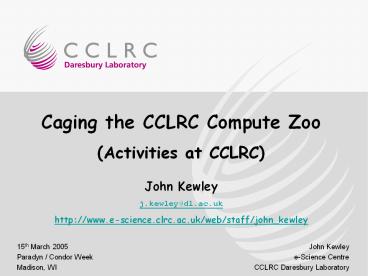Caging the CCLRC Compute Zoo - PowerPoint PPT Presentation
Title:
Caging the CCLRC Compute Zoo
Description:
Of minimal use for HTC. Presenter Name. Facility Name ... Other non-HTC Uses ... I have several server-licensed products and many potential occasional users. ... – PowerPoint PPT presentation
Number of Views:39
Avg rating:3.0/5.0
Title: Caging the CCLRC Compute Zoo
1
Caging the CCLRC Compute Zoo (Activities at
CCLRC) John Kewley j.kewley_at_dl.ac.uk http//www.e
-science.clrc.ac.uk/web/staff/john_kewley
2
Outline
- What is a Compute Zoo?
- Caging Problems
- A Trip to the Zoo
- Uses for a Compute Zoo
3
What is a Compute Zoo?
4
Compute Farm
- Homogenous large numbers of (near) identical
resources - Often co-located physically a training room, lab
workstations or a large cluster - Centrally managed, often by dedicated staff
- Typical of many Condor Pools excellent for High
Throughput Computing
5
Compute Farm
6
Compute Zoo
- Heterogeneous resources are of many different
operating systems and architectures - Located across a site
- Individually, or variously managed
- Of minimal use for HTC
7
Compute Zoo
8
Caging Problems (Firewall Mirroring)
9
Firewalls within a Condor Pool
- Some resource owners have firewalls on their
personal workstations - Since Condor needs each submit node to be able to
talk to every potential execute node, this
necessitates the opening of every firewall in the
pool to every submit node when it is added. - Between adding the new node and the firewalls
being updated, the firewalled nodes will be
unavailable for use. - Or are they?
- Maybe someone should tell Condor!
10
Adding a new machine to the pool
- If we add a new machine to the pool, the existing
firewalls may not have anticipated this. - The firewalls will likely block this new machine
- A Job may still match for the newly added machine
to the firewalled resource. - This job will not be able to run
- Parts of the system can jam as a result.
- condor_q on submitting node
- Subsequent parts of the submit script
- (maybe also parts of the central node)
11
Private networks
- Similar "jams" occur if part of your pool (or
flock of pools) is on a network that is
unavailable to some of the other nodes - How can we permit jobs from submit nodes that can
access the private network to run on these nodes
whilst preventing Condor sending jobs from other
submit nodes there?
12
How can we get round this?
- Restrict the number of submit nodes
- Automatically update the firewall files
- Ensure everything is up-to-date
- Permit pool to evolve whilst persuading Condor to
avoid going to nodes where the job cant run
13
Firewall Mirroring (1)
- Each machine with a firewall declares the fact in
its ClassAds - HAS_FIREWALL TRUE
- Also, which machines and/or subnets it permits to
access its Condor ports (mirroring FW table
settings) - FW_ALLOWS_113 TRUE
- FW_ALLOWS_rjavig6 TRUE
- Finally, it needs to export these settings
- STARTD_EXPRS HAS_FIREWALL, FW_ALLOWS_113, \
FW_ALLOWS_rjavig6
14
Firewall Mirroring (2)
- To ensure that jobs can only go to resources they
can reach, - Ensure that submit machines declare their subnet
and hostname - MY_SUBNET 113
- MY_HOST condor
- Use these value in the following expression which
is added to all REQUIREMENTS for jobs from this
machine - APPEND_REQUIREMENTS ( \
- (HAS_FIREWALL ! TRUE) \
- (FW_ALLOWS_(MY_HOST) TRUE) \
- (FW_ALLOWS_(MY_SUBNET) TRUE) )
15
And Private Networks?
- Same solution can be used for private networks by
pretending they have a firewall and declaring
which other nodes have access to that network
16
A Trip to the Zoo (Viewing the Pool)
17
The CCLRC Compute Zoo
- 2x Windows XP Professional
- 2x Windows 2000 Professional
- 1x Windows NT 4.0 Workstation
- 7x SuSE Linux 9.0
- 2x SuSE Linux 8.0
- 1x SuSE Linux 9.1
- 5x White Box Enterprise Linux 3.0
- 1x Red Hat Enterprise Linux AS release 3.0
- 1x Red Hat Enterprise Linux WS release 3.0
- 3x Red Hat Linux 9
- 2x Red Hat Linux 8.0
- 2x Red Hat Linux 7.3
- 1x Mandrake Linux 10.1
- 1x Gentoo Linux 1.4
18
Viewing the Pool
- http//tardis.dl.ac.uk/Condor/cgi-bin/CondorStatus
.cgi - http//tardis.dl.ac.uk/Condor/cgi-bin/WiscStatus.c
gi
19
Uses of a Zoo
20
Build and Test
- The CCLRC pool was part of the UK Grid
Engineering Task Force Build and Test project. - Software bundles were distributed to a variety of
OS types around the flocked pool for building and
testing. - This type of (flocked) pool relies on
heterogeneity and small numbers of each type are
all that are required. - http//polaris.ecs.soton.ac.uk65000/
- http//wiki.nesc.ac.uk/read/sfct?HomePage
21
Other non-HTC Uses
- I want to ensure my code compiles without
warnings and/or runs its basic tests on - As many OSs as possible
- With as many different compilers as possible
- I want to perform a release build of my product
for platform X, but I only have accounts on A, B
and C - I have several server-licensed products and many
potential occasional users. How can this be made
available to them more easily (within the bounds
of the licence of course!)
22
What other uses are there for a Compute Zoo?































